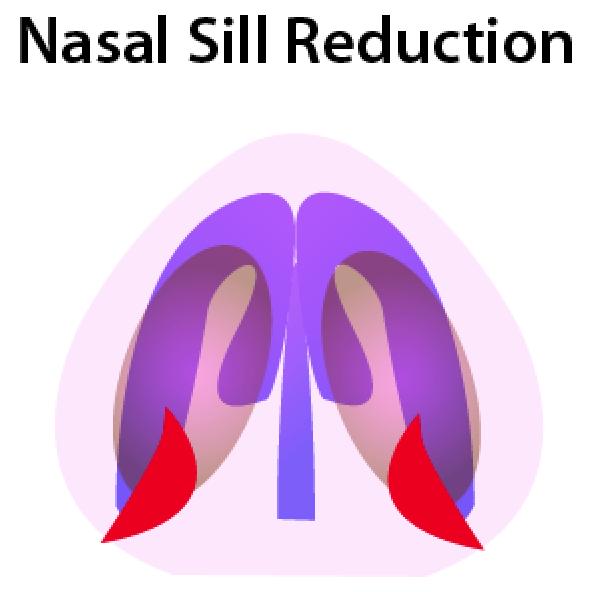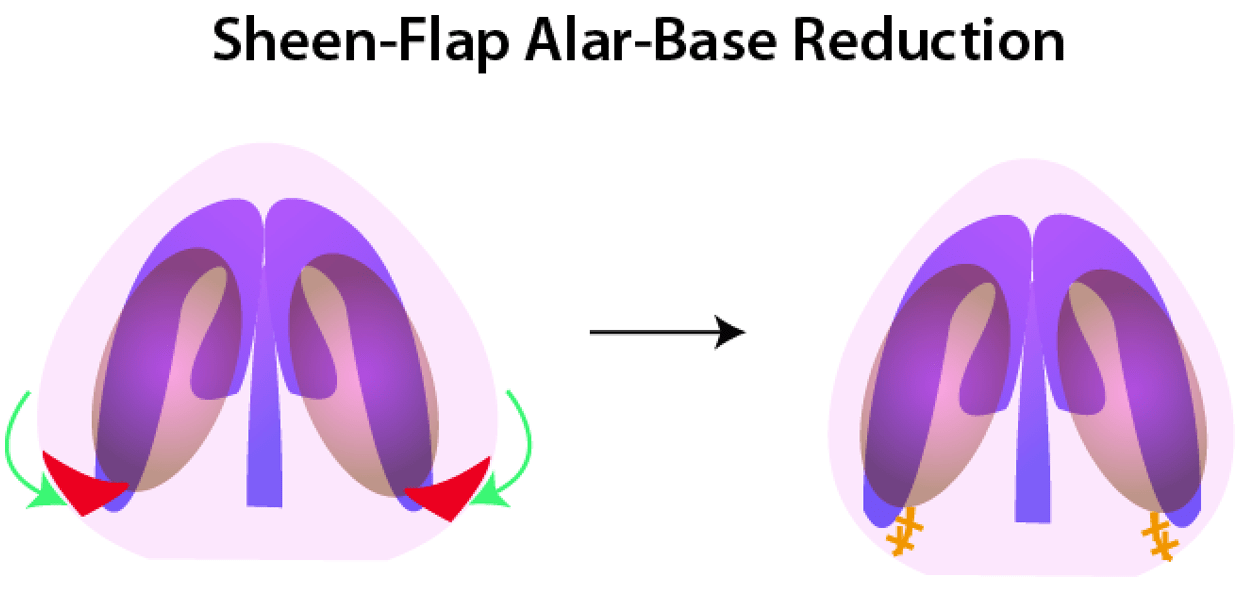Rhinoplasty for the Nasal Tip
Jump To:
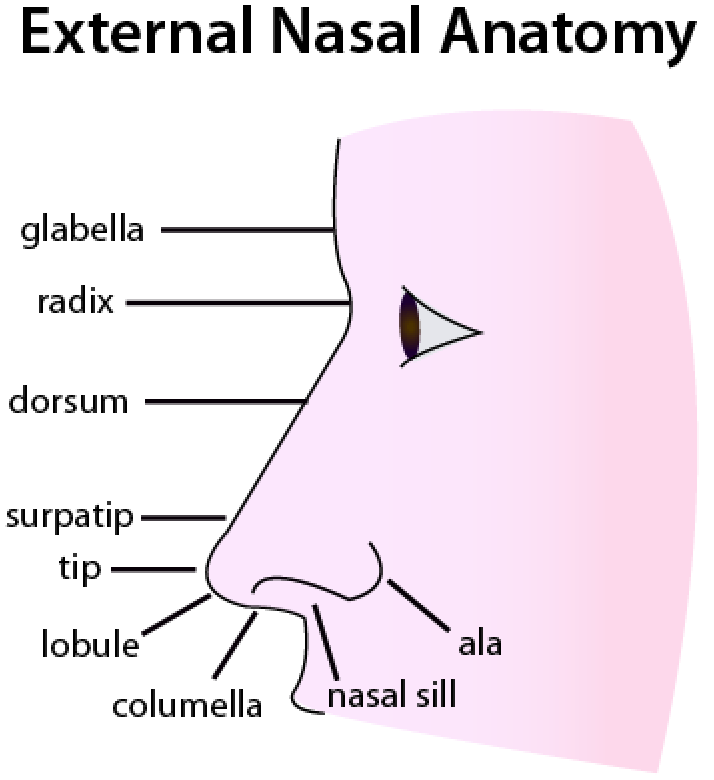 The nasal tip is perhaps the most complex component to most rhinoplasty procedures. Not every technique that Dr. Lam performs for the nasal tip can be recounted in this section, and most often times it is too complicated to actually explain all of the details to a non-medical audience. However, today’s consumers are becoming increasingly more sophisticated and are interested in understanding the technical details of what Dr. Lam performs during his procedures to achieve reliable, safe, and aesthetically pleasing results that are functionally stable. This section will be divided into the major techniques that Dr. Lam uses in his rhinoplasties but will certainly only represent a small fraction of the methods that he uses.
The nasal tip is perhaps the most complex component to most rhinoplasty procedures. Not every technique that Dr. Lam performs for the nasal tip can be recounted in this section, and most often times it is too complicated to actually explain all of the details to a non-medical audience. However, today’s consumers are becoming increasingly more sophisticated and are interested in understanding the technical details of what Dr. Lam performs during his procedures to achieve reliable, safe, and aesthetically pleasing results that are functionally stable. This section will be divided into the major techniques that Dr. Lam uses in his rhinoplasties but will certainly only represent a small fraction of the methods that he uses.
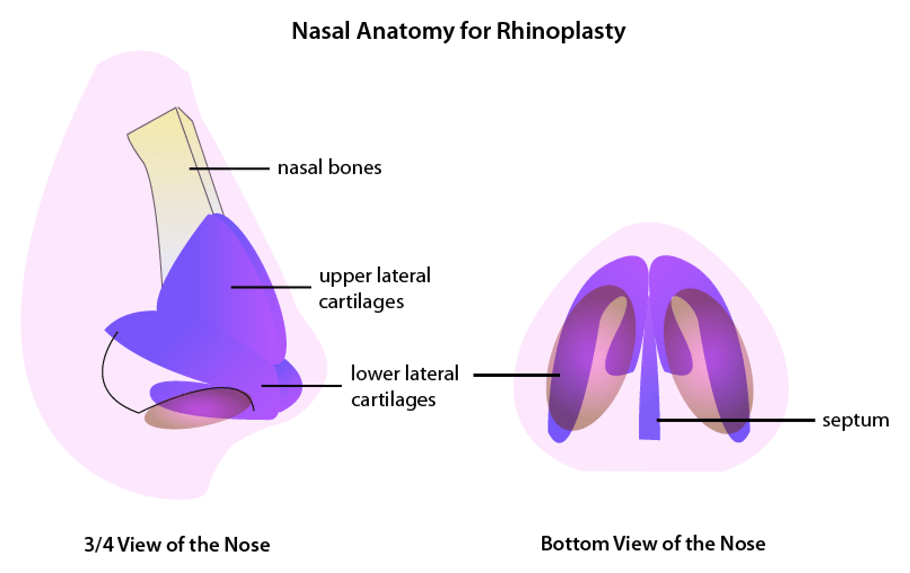
Caudal Septal Extension Graft
This is perhaps the single most important method that Dr. Lam uses today to perform his nose surgery and uses it in almost every single operative case. The cartilage graft extends and connects the nasal tip cartilages directly to the stable and anchored septum (the cartilage that divides both nostrils). In the past, Dr. Lam performed a columellar strut, which was a small piece of cartilage floating between the nasal tip cartilage to provide support since support is lost when the nose is opened and operated upon. However, this older method led to unpredictable outcomes where only a week after the procedure the tip could fall slightly or significantly and even continue to change over a period of several months.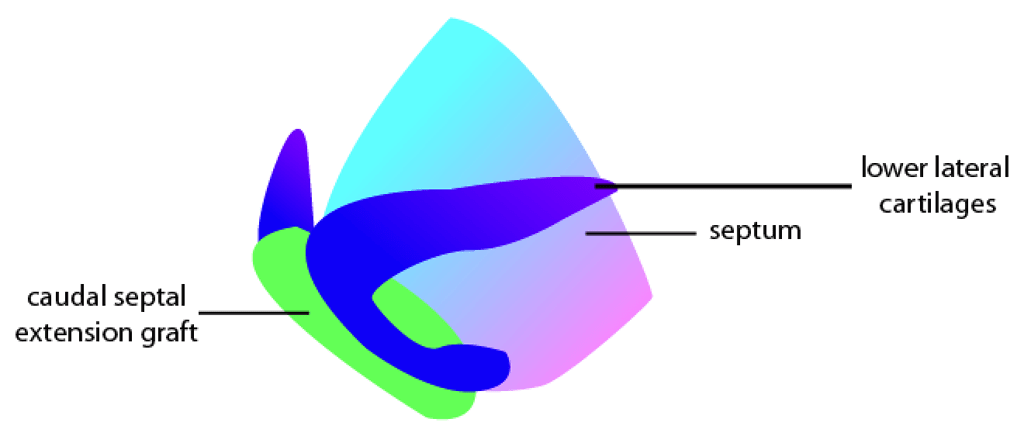
Lateral Turn-in Flap
Video: Lateral Turn-In Flap Explained
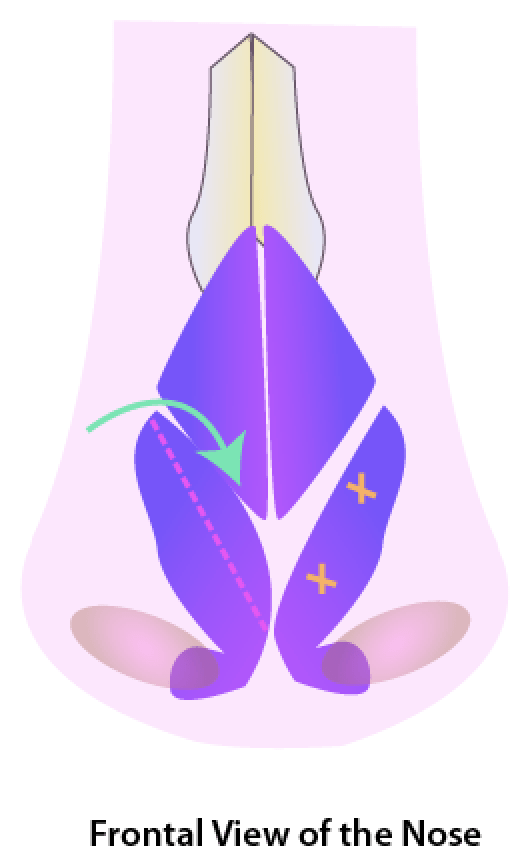 The bulbous and full nasal-tip appearance is considered unattractive in every race and ethnicity, whereas a more refined nasal-tip appearance is desirable. The older method of reducing this fullness involved cutting out the top portion of the bulbous cartilage in a move known as a cephalic trim. The problem with this method is that it weakens the nasal-tip cartilage predisposing it toward functional and cosmetic collapse. The lateral turn-in flap instead involves scoring the top half of the cartilage and turning in the flap onto the lower half of the cartilage. This method achieves the same result as the older cephalic trim but has two clear advantages. The nasal-tip structure actually becomes stronger rather than weaker after this maneuver, which creates a better aesthetic and functional stability. In addition, when the convex, bulging nasal tip cartilage is flipped onto itself the cartilage actually becomes rigidly flat, which further reduces the bowing effect of the cartilage and thereby the bulbosity and fullness. Contrast this method with the older cephalic trim method and even though the cartilage is halved in size, the weaker cartilage can actually now have a greater tendency to bow outward due to the weakening effect on the cartilage by virtue of thinning it down. Combined this lateral turn-in method with the above-described CSEG and the nasal tip is incredibly stable rather than weaker and thinner.
The bulbous and full nasal-tip appearance is considered unattractive in every race and ethnicity, whereas a more refined nasal-tip appearance is desirable. The older method of reducing this fullness involved cutting out the top portion of the bulbous cartilage in a move known as a cephalic trim. The problem with this method is that it weakens the nasal-tip cartilage predisposing it toward functional and cosmetic collapse. The lateral turn-in flap instead involves scoring the top half of the cartilage and turning in the flap onto the lower half of the cartilage. This method achieves the same result as the older cephalic trim but has two clear advantages. The nasal-tip structure actually becomes stronger rather than weaker after this maneuver, which creates a better aesthetic and functional stability. In addition, when the convex, bulging nasal tip cartilage is flipped onto itself the cartilage actually becomes rigidly flat, which further reduces the bowing effect of the cartilage and thereby the bulbosity and fullness. Contrast this method with the older cephalic trim method and even though the cartilage is halved in size, the weaker cartilage can actually now have a greater tendency to bow outward due to the weakening effect on the cartilage by virtue of thinning it down. Combined this lateral turn-in method with the above-described CSEG and the nasal tip is incredibly stable rather than weaker and thinner.
Tongue-in-Groove Technique
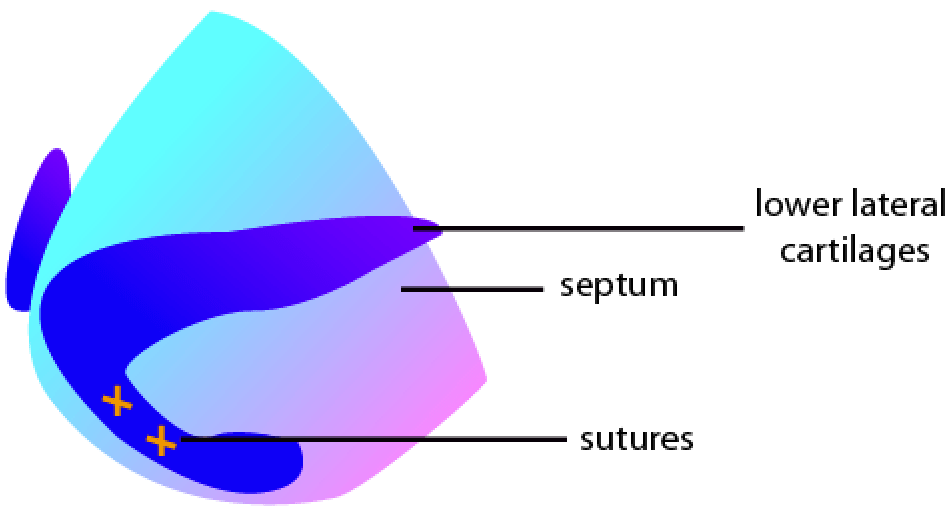 For patients whose nose tips droop downward and show an excessive degree of nostril show from the side view, Dr. Lam can perform a so-called tongue-in-groove technique to improve this unaesthetic appearance. It is very similar to a CSEG method. However, no graft is needed to extend the septum because the longer septum is long enough to be used to tack the drooping nasal-tip cartilages upward to a firm anchoring position. At times, the long septum is so excessive that it also requires some additional trimming if it extends too far inferiorly even beyond the use of it as an extension graft.
For patients whose nose tips droop downward and show an excessive degree of nostril show from the side view, Dr. Lam can perform a so-called tongue-in-groove technique to improve this unaesthetic appearance. It is very similar to a CSEG method. However, no graft is needed to extend the septum because the longer septum is long enough to be used to tack the drooping nasal-tip cartilages upward to a firm anchoring position. At times, the long septum is so excessive that it also requires some additional trimming if it extends too far inferiorly even beyond the use of it as an extension graft.
Lateral Crural Strut Graft
When the outer nostril cartilages are very weak usually caused by a prior nose job, Dr. Lam must restore the integrity of these weakened cartilages to help with the aesthetic appearance but most oftentimes to restore functional strength to the nostril. The nasal tip oftentimes appears to collapse inward during inspiration (breathing inward) and with forceful inhalation may fully collapse causing nasal obstruction. Dr. Lam uses a piece of cartilage to reinforce this nostril cartilage from collapsing. The lateral crural strut graft provides this strong support and can dramatically improve breathing and help stabilize a previously weakened nasal-tip cartilage.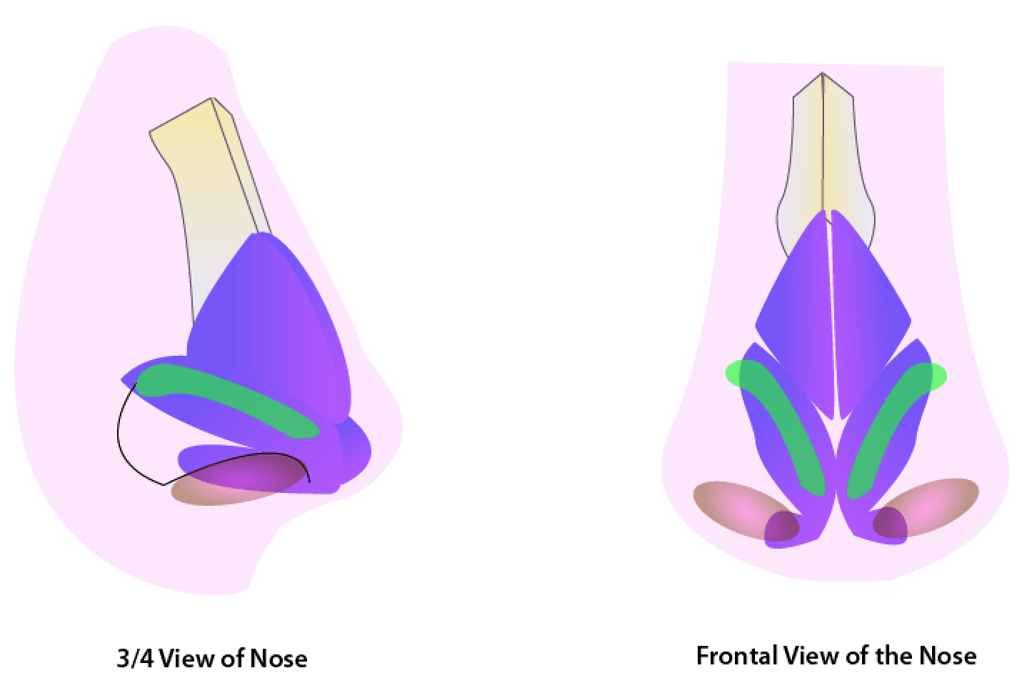
Double Dome-Binding Suturing
A nasal tip that is bulbous in appearance can be further refined using dome suturing to narrow the widened nasal-tip appearance. Traditionally, this suturing of the nasal tip was done to tie both sides into a single nasal tip, but this older technique known as a single dome-binding suture led to the nose being pinched in appearance or creating an unnatural “unitip” appearance. Dr. Lam believes that this nasal tip appearance is undesirable and keeps a slight separation to his nasal tip so that the tip appearance looks natural. When a photographer takes a photograph of a face, you will see that there are two little white dots of light that can appear bouncing off the two cartilage mounds, especially in Caucasian noses but less appreciated oftentimes in ethnic noses with thicker skin. Nevertheless, it is important not to overly pinch the nasal tip inward to create a single light reflex in the nasal tip since in certain lighting or all the time the nose tip may not look natural.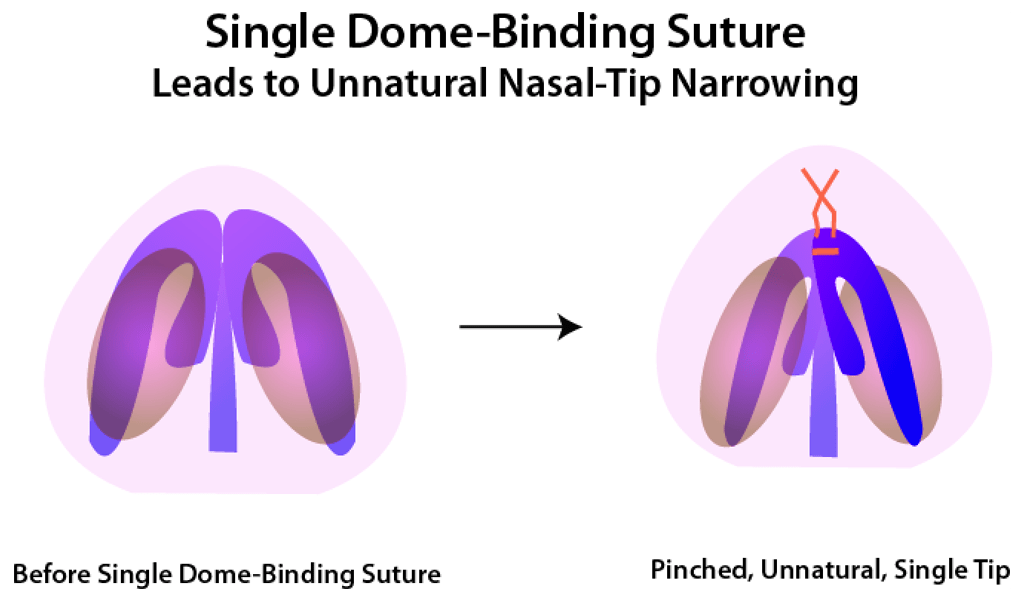
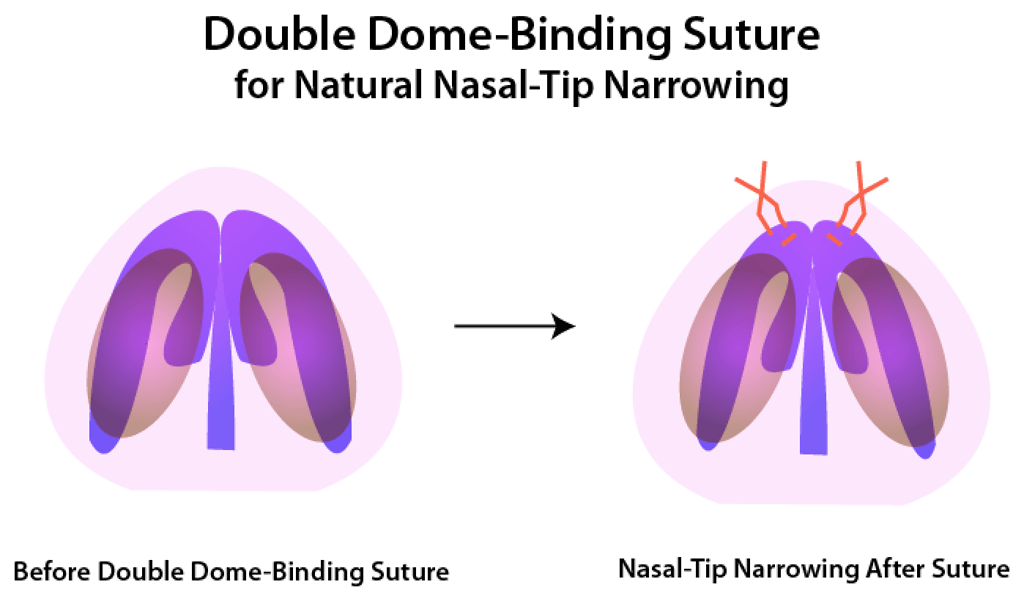
Nasal Sill and Alar-Base Reduction
The nostril width is oftentimes a major concern for many individuals seeking rhinoplasty. An important consideration when determining whether to reduce the width of a nostril is how wide the central nasal tip appearance is. If the outer nostril is greatly reduced and the nasal tip cannot be entirely or adequately reduced, the nose will appear worse since narrowing the nostrils will exaggerate the appearance of the width of the central nasal tip. All you have to do to appreciate this problem is to pinch the sides of your nose too far in and look at your nostril tip. You may see that the tip now looks very bulbous in appearance. Accordingly, Dr. Lam only addresses the nostril width at the very end of the surgery when he is done modifying the nasal tip and the bridge. Only then can he appreciate whether the sides would merit reduction without adversely affecting the appearance of the central nasal tip. In addition, if the nasal tip is overprojected (protrudes too far out) and is then brought back to the face, the nostrils will flare more and additional reduction may be needed. Conversely, if the nasal tip is lengthened forward and narrowed, the nostrils may be sufficiently narrowed not to require separate treatment. The method that Dr. Lam performs typically is known as a nasal-sill reduction in which he reduces the width of the nostril itself along the area where the central nostril touches the upper-lip skin. This method minimizes scarring and optimizes reduction of the nostril width most effectively. If that still fails to address the flare of the nostril, then he will perform what is known as a Sheen flap to reduce the flare while preserving the natural curvature of the nostril.